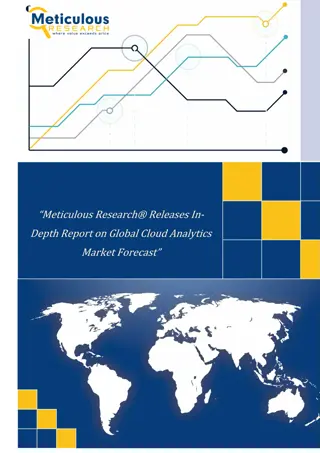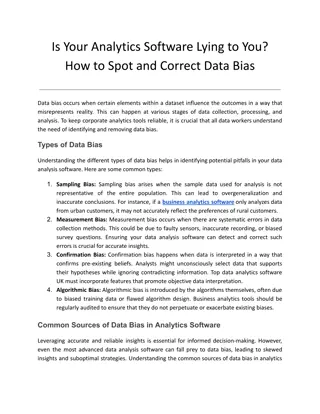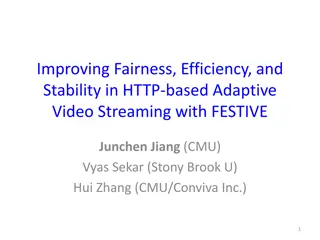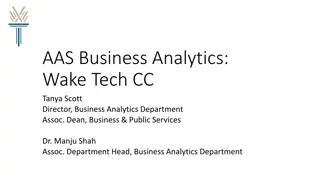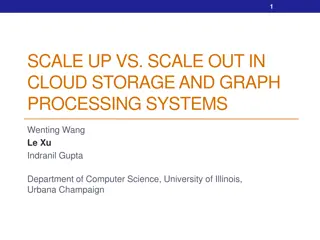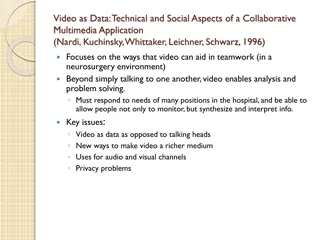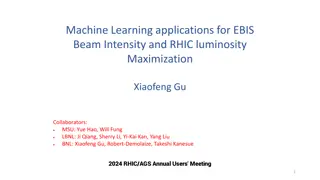Live Video Analytics at Scale: Resource Management and Quality Optimization
This presentation discusses the challenges and solutions related to live video analytics at scale, focusing on resource management, quality optimization, and trade-offs with multi-dimensional configurations. The speaker explores the motivation behind the need for efficient resource allocation in video analytics and provides real-world examples and core ideas for tackling the complexities associated with processing large amounts of video data in real-time.
Download Presentation

Please find below an Image/Link to download the presentation.
The content on the website is provided AS IS for your information and personal use only. It may not be sold, licensed, or shared on other websites without obtaining consent from the author.If you encounter any issues during the download, it is possible that the publisher has removed the file from their server.
You are allowed to download the files provided on this website for personal or commercial use, subject to the condition that they are used lawfully. All files are the property of their respective owners.
The content on the website is provided AS IS for your information and personal use only. It may not be sold, licensed, or shared on other websites without obtaining consent from the author.
E N D
Presentation Transcript
Live Video Analytics at Scale with Approximation and Delay-Tolerance Presenter: Kaishen Wang 1
Outline Motivation Core Ideas (Offline + Online, Implementation) Experimental Data Thoughts Take Away Points 2
Motivation (1) Video Cameras are pervasive (surveillance, business intelligence, traffic control and crime prevention) Video analytics can have very high resource demands (the best tracker processes only 1 frame/sec on an 8- core machine, DNN requires 30GFlops to process a single frame) Resource Management is Important. Resource-quality trade-off with multi-dimensional configurations Variety in quality and lag goals 3
Motivation (2) Why Resource-quality trade-off with multi-dimensional configurations? Vision algorithms typically contain various parameters, or knobs Multiple knobs -> Configuration Resource demand can be reduced by changing configurations Find the best configuration 4
Motivation (3) Real Word Examples: License Plate Reader (a&b) Deep Neural Network (DNN) Classifier (c) Object Tracker (d) Ref: https://www.usenix.org/system/files/conference/nsdi17/nsdi17-zhang.pdf 5
Motivation (4) Why Variety in quality and lag goals? Quality VS Lag (temporarily reallocating some resources from the lag-tolerant queries during interim shortage of resources). See the following example: counting cars for traffic control License plate readers for tolling License plate readers for amber alert Quality moderate quality high quality high quality Lag No Lag Tolerate Lag No Lag 6
Core Ideas - Overview on VideoStorm Offline: generate model and reduces config space, solving the first challenge) Online: optimization, solving the second chanllenge 7 Ref: https://www.usenix.org/system/files/conference/nsdi17/nsdi17-zhang.pdf
Core Ideas - Offline Profiling Goal: find mapping configuration -> resource demand & quality compute against a labeled dataset or a golden query configuration (known to produce high-quality results, expensive) 8 Ref: https://www.usenix.org/system/files/conference/nsdi17/nsdi17-zhang.pdf
Core Ideas - Online (Utility Function and Scheduling) for each query, user provides a utility function to scheduler, which encodes the quality and lag requirements of each individual query, the bold part is defined by user Q_M and L_M: the minimum quality required and maximum lag it can tolerate U(Q,L) = U (Q=Q_M, L=L_M) + coefficient1 * (Q-Q_M) - coefficient2*(L-Q_L) scheduling resources cluster managers like Yarn and Mesos: resource fairness for each query goal: maximize the minimum utility (max-min fairness) or sum of utilities tolerate lags (in case of resource shortage) 9
Core Ideas - Online (Example) Example of how scheduler allocate resources among three different queries, which tolerate some lag and maximize the utility 10 Ref: https://www.usenix.org/system/files/conference/nsdi17/nsdi17-zhang.pdf
Core Ideas - Implementation Key points: input: list of knobs, resource-quality profiles and lag goals machine-level managers in the cluster frameworks pull work VideoStorm manager pushes new queries and configuration changes to the machine-managers machine managers autonomously handle short-term fluctuations Interfaces: Processing: byte[] Process(header, data) Configuration: Update(key, value) 11
Experimental Data - SetUp Video Analytics Queries: license plate reader, car counter, DNN classifier, object tracker Video Datasets: obtained from real and operational traffic cameras in Bellevue and Seattle cities for two months (Sept. Oct., 2015), stream the recorded videos at their original frame-rate (14 to 30 fps) and resolution (240P to 1080P) to mimic the live video stream Azure Deployment: One VideoStorm manager+ 100 Workers Baseline: work-conservative fair scheduler (widely-used scheduling policy for cluster computing frameworks like Mesos) 12
Experimental Data - Performance Improvements Deployment on an Azure cluster of 101 machines shows improvement by as much as 80% in quality of real-world queries and 7 better lag 13 Ref: https://www.usenix.org/system/files/conference/nsdi17/nsdi17-zhang.pdf
Experimental Data - Accounting for Errors It can handle errors in profiles with adaptation. 14 Ref: https://www.usenix.org/system/files/conference/nsdi17/nsdi17-zhang.pdf
Experimental Data - Scalability Even with thousands of queries, VideoStorm make its decisions in just a few seconds. This is comparable to the scalability of schedulers in big data clusters 15 Ref: https://www.usenix.org/system/files/conference/nsdi17/nsdi17-zhang.pdf
Thoughts Good project + good paper, Innovations at different levels Criticisms: Definition of quality of video Improvement on utility function (e.g., non-linear reward and penalty) Able to drop frames to catch up & approximation How about performance in lack of resource? (No example) 16
Take Away Points for VideoStorm Traditional live video analytics are resource consuming We can turn knobs to save resources Offline profiling generates candidates of best configurations Online Scheduling use utility function and specific goal (sum-max utility or min-max utility) to allocate resources for different queries and tolerate lag Query placement techniques (e.g. lag spreading) Single machine can handle some fluctuation in resource demand VideoStorm outperforms fair scheduler in both quality and lag reduction VideoStorm can handle erroneous profiles and resource capacity change VideoStorm has good scalability and low transform overhead 17
Thanks. 18
Encoding, Fast and Slow: Low-Latency Video Processing Using Thousands of Tiny Threads Sadjad Fouladi, Riad S. Wahby, Brennan Shacklett, Karthikeyan Vasuki Balasubramaniam, William Zeng, Rahul Bhalerao, Anirudh Sivaraman, George Porter, Keith Winstein Presenter: Xiaofo Yu 19
Outline Motivation Interactive video processing application Parallel supercomputing on commercial cloud Core Ideas - ExCamera s Two Major Contributions Experiments Takeaways & Discussions 20
Background & Motivation Need for interactive video-processing applications. (Google Docs for Videos) Execute video-processing tasks quickly (low latency). Make results immediately available online. Video jobs take lots of CPU hours. Need thousands of threads up instantly assuming job is parallelizable. Hard to find suitable cloud service for massive heavyweight parallelism. Video encoders use only coarse-grained parallelism. Video processing jobs need efficient video encoding. (70% network traffic are encoded videos) Video encoding relies on temporal correlations among nearby frames. The finer the parallelism, the worse the encoding efficiency (Cannot exploit correlations). 21
Background & Motivation Advantages of Cloud Function Service IaaS provides VMs but takes minutes to boot and bills in hours. (AWS EC2) Microservice frameworks provides event-driven workers start up instantly. (AWS Lambda) Drawbacks of AWS Lambda Microservice frameworks are designed for asynchrounous lightweight tasks. Target for massive parallel heavyweight computations and communications. Lambda functions must be installed then invoked. Longer time to install than invoke. Time of worker invocations. Cold Start vs Warm Start. Limit on the number of workers. 100 -> 1200 per AWS region. NAT-traversal needed for worker communications. Limited worker execution time. 5min. 22
Core Ideas: ExCamera Contributions A framework that can run thousands parallel jobs on a commercial cloud. Uses microservice frameworks - AWS Lambda, Google Cloud Functions, Azure Functions. Starts up instantly(milliseconds). Quicker. Bills usage in sub-second increments. Cheaper. Allow arbitrary executables. Flexible. Starts up thousands of threads in seconds. Manages communication among threads. A video encoder for massive fine-grained parallelism. Encodes tiny chunks of video using many threads together. Slow work done in parallel. Fast serial pass to stitch chunks together. Fast work done in serial. 23
Core Ideas: ExCameras Execution Engine - mu mu s High Level Designs - Address the limitations of AWS Lambda. Central Coordinator with dependency aware scheduling. No deadlock and faster completion. Workers use same generic Lambda function guided by Coordinator. Always warm start. Rendezvous Server to coordinate communications among workers. Number of worker and execution time limit still unsolved Architecture Workers - short-lived Lambda function invocations Coordinator - long-lived server controlling executions using per-worker FSM descriptions. Rendezvous Server - Simple relay server for communication among workers. 24
Core Ideas: ExCameras Execution Architecture Lambda functions - thousands of workers/threads 25
Core Ideas/Background: Video Encoding Existing Video Encoding Techniques Exploit temporal similarities among nearby frames. Key Frame - image which is stored entirely. (Typically first one) Need several MBs storage. Interframe - only stores the difference from the previous image. KBs of storage. Serial vs Parallel Serial: Encode(Image[1:100]) = Key Frame + Interframe[2:100] Parallel: Encode(Image[1:10]) = kf1 + Interframe[2:10] Encode(Image[11:20]) = kf11 + Interframe[12:20] Encode(Image[91:100]) = kf91 + Interframe[92:100] More key frames => worse compression efficiency => high latency. 26
Core Ideas: ExCameras Video Encoder & Decoder Mid-stream encoding needs access to intermediate computations. Formulate this information using state (in Automaton). Need to import/export state information explicitly. state = (prob_model, references[3]) Ref: http://www.cs.utexas.edu/~swadhin/reading_group/slides/exCamera.pdf p24 27
Core Ideas: Explicit State-Passing Style Make the state object explicit - Can be transmitted over the network, etc. decode(state, compressed_frame) -> (state , image) decode(*, key_frame) -> (state , image) encode-given-state(state, image, quality) -> interframe Can encode given an external state. Key frame can be replaced with interframe (chunk i-1). Not as good as Google s vpxenc rebase(state, image, interframe) -> interframe Transform already compressed frames to a different one based on another state. No need to redo the slow part. (Better than encode from scratch) Can work with encode to stitich chunks of compressed videos together. (Serial Work) 28
Core Ideas: Parallel-Serial Algorithm ExCamera[N,x] 1. Each threads downloads an N-image chunk of raw video. (11MBs per image for 4K resolution) 2. Each threads run encoder(vpxenc) => 1 Key Frame + N-1 Interframes. 3. Each threads run decode N times to find final state and send to next thread. 4. 2...X threads run encode-given-state to encode first image as interframe. First thread already finishes and uploads videos. Key frames from 2nd threads are thrown away. 5. 2...X threads run rebase serially to rewrite interframes 2...N in each thread. Rebase can be done quickly so serial run is fine. 29
Microbenchmark encode-given-state takes longer than vpxenc s encode 30 Ref: https://www.usenix.org/system/files/conference/nsdi17/nsdi17-fouladi.pdf
Methods & Metrics Task: 4K movies of 15-minute animated Sintel and 12-minute Tear of Steel . Baselines: vpx(single-threaded), vpx(multi-threaded) Metrics: 1. Latency: Time-to-completion 2. Bitrate: Compressed size / duration 3. Quality: structural similarity (SSIM) 4. Cost: $5.4 to encode 15-minute Sintel 31
Results ExCamera[6,16] performs within 2% of the same quality to bitrate compared to vpx(multi) 9% on live-action movie 32 Ref: https://www.usenix.org/system/files/conference/nsdi17/nsdi17-fouladi.pdf
Results 60X to 300X faster than vpx(multi) 33 Ref: https://www.usenix.org/system/files/conference/nsdi17/nsdi17-fouladi.pdf
Summary 34 Ref: https://www.usenix.org/system/files/conference/nsdi17/nsdi17-fouladi.pdf
Summary & Takeaways Target: low latency video processing application Major contributions General purpose parallel supercomputing framework based on AWS Lambda Fine-grained parallel video encoding which is much faster. Ideas worth exploring Single lambda function to ensure warm start on cloud. Explicit state-passing: useful for midstream computations for video-processing Rebase technique to avoid redoing slow work serially. 35
Discussions of Limitations Experiments with only two videos. Faster but compression is worse. Scalability issues if ExCamera s workload become popular on AWS Lambda. Encode-given-state is slow and inefficient. Complex pipeline specifications. Fault-tolerance: worker failure kills entire job, coordinator failure, etc. Fine-grained parallelism may not be necessary Assumes video already in cloud (S3). 36
Paper Discussion Scriber: Hyun Bin Lee 37
VideoStorm: Online Profiling What kind of things should we consider when constituting a labeled dataset for pre-profiling the queries? Sophisticated hyperparameter searches for profiler is suggested as a future work. 38
VideoStorm: The Quality-aware Scheduler Greedy Algorithm Starvation: what about non-low latency tasks? Maximize total utility Evaluation only against fair scheduler What kind of scheduling algorithm can we use as an alternative? 39
VideoStorm: USENIX Q&A Soft Real-time system: no hard deadline, but penalty imposed when deadline is missed User Interaction with the Utility Function Configuration four parameters (only allow users to choose pre-defined values) may not support all objectives since configuration combinations are limited only provide high level goals and adjust during online phase 40
ExCamera: Dependence on the Amazon Lambda Use AWS Lambda as a supercomputer (Sadjad Fouladi from USENIX NSDI 17 presentation) Pros Cheap (compared with other alternatives like EC2) Fast (56x faster than existing state-of-the-art Google encoder) Cons Lack of sufficient evaluation due to limitations imposed by Amazon Lambda May need to change parameters (number of Lambda workers, size of each chunk and etc.) depending on how Lambda is being used by others May cause Amazon to change how lambdas work 41
ExCamera: No Failure Recovery Lack of fault-tolerance is pointed out by many students. Acceptable? 42
ExCamera: USENIX Q&A Q: Storage System for ExCamera? A: Raw Video stored in S3 Q: This can be a bottleneck for the system. What is your opinion? A: Did not experience performance issue regarding storing and loading the video Q: Is this really cheap ? 43







